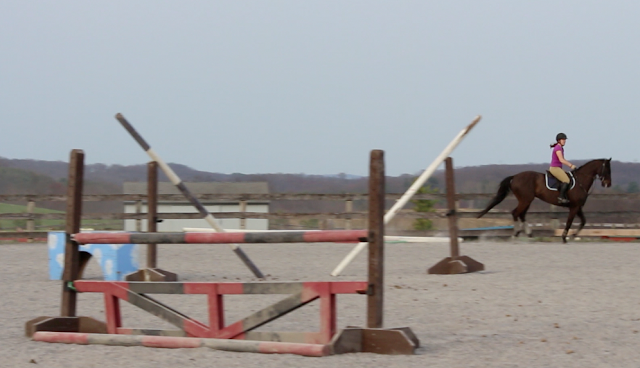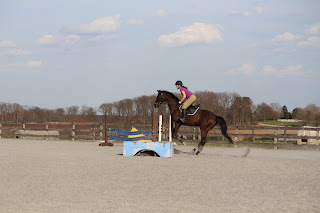Spring Training Canter Exercises
Jumping
Canter exercise #1Kristy gave me an interesting exercise last week to help me work on my course canter without even jumping. She used jump standards to set up an open "V" formation (seen in the photo above). Leo and I walked, trotted and cantered between the poles. Interestingly, it replicated the stride length, tempo and rhythm changes that we have in stadium. Leo would anticipate the structure, the same as he would a fence. We worked on maintaining a steady rhythm and stride while cantering between the poles.
Canter exercise #2
We also cantered a small - REALLY small - vertical on a circle. Again, just focusing on the canter. Kristy wanted to give me exercises I can incorporate into our daily flatwork which don't tax Leo's legs but can help with our canter work all the same. The goal is just to maintain the same length of stride, rhythm and impulsion regardless of the obstacle. One thing I have to work on, is keeping my leg on at the base of and over the jump - even when Leo gets fast. My leg helps generates energy and Leo just has to get used to feeling it.
Dressage
Leo and I also had a dressage lesson with Phoebe DeVoe today. As usual, it was an awesome experience. I wish I had Phoebe at my disposal every week! There's something about the way she teaches which helps you to develop a real feel for riding. She gives such clear advice to correct an issue - at one point, Leo wasn't straight in his shoulders at the canter or settled in the contact and she said to apply and release thigh pressure and he actually straightened out and relaxed into the bridle!Canter exercise #3
Phoebe had another canter exercise to help me learn to ride Leo's canter. It's super simple! Here it is: Canter in long stretches - i.e. multiple times around the ring without stopping. She said this helps the rider learn to adjust to and correct changes in the horse's balance over time which will also help me in my course work. How easy is that?? Leo is still quite fussy at the canter (in all his gaits really) but the longer I cantered, the better the quality canter I could create and the more settled he got. Phoebe pointed out that is takes a lot of strength to canter correctly so its good to spend a lot of time practice on it.
Other insights:
- Rider Leadership: She said that because Leo likes to disregard rider input, it's important for me to make him do the opposite of what he wants to do. If he wants to go slow, I should ask him to go fast. If he wants to go fast, I should ask him to go slow. This will help get him listening to me.
- Transitions: She also thinks with the flat work the more I can do with my thighs, versus my lower leg, the better - because Leo is so reactive. Another tip she gave me was to tip my pelvis forward in my downward transition (canter to trot) so that I am not sitting too deep in the saddle and driving him with my seat. This helps keep my seat light on his back.
- Straightness: In order to keep Leo's hind leg moving under him and keep his shoulders straight, I should use counter flexion. Around the ring, rather than riding my inside leg to outside rein, I rode my outside thigh to outside rein. Phoebe would also have me leg-yield off the rail for a couple strides to help achieve the straightness. On a circle we worked on spiraling in, leading with Leo's barrel with a slight counter bend and then steering out to a larger circle (which again focuses on Leo keeping his body straight - versus leg-yeilding out to the larger circle).
- Lengthenings: In my mind I need to focus on Leo lifting his shoulders, not going faster. I should also grow the lengthening, not expect it from the start - when I do I chase him forward.
- Practicing the test: Phoebe helped me work on parts of my training level dressage test without actually practicing the test. She said to break the test into components and then integrate those parts into my flatwork. For example, one portion of the test is canter right lead to X, trot and pick up left lead canter at the end of the diagonal. We would practice, trotting across the diagonal and pick up the canter at the end - not the full movement.






Comments
Post a Comment